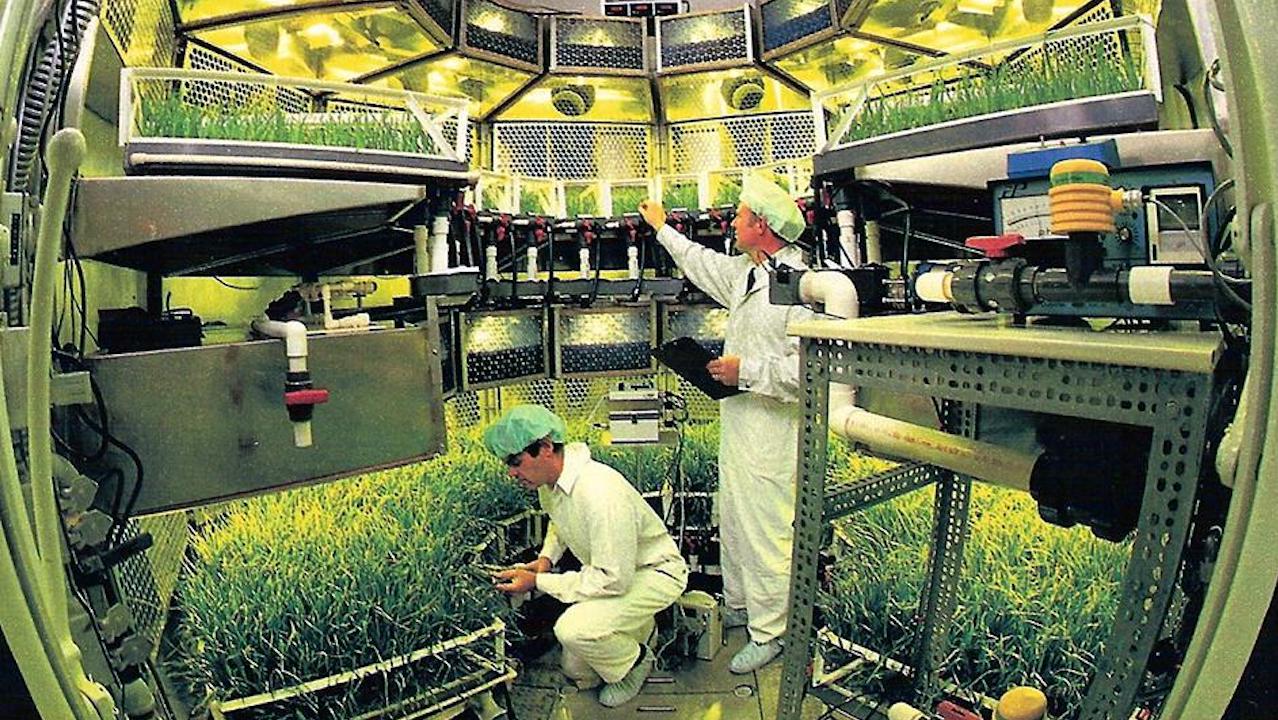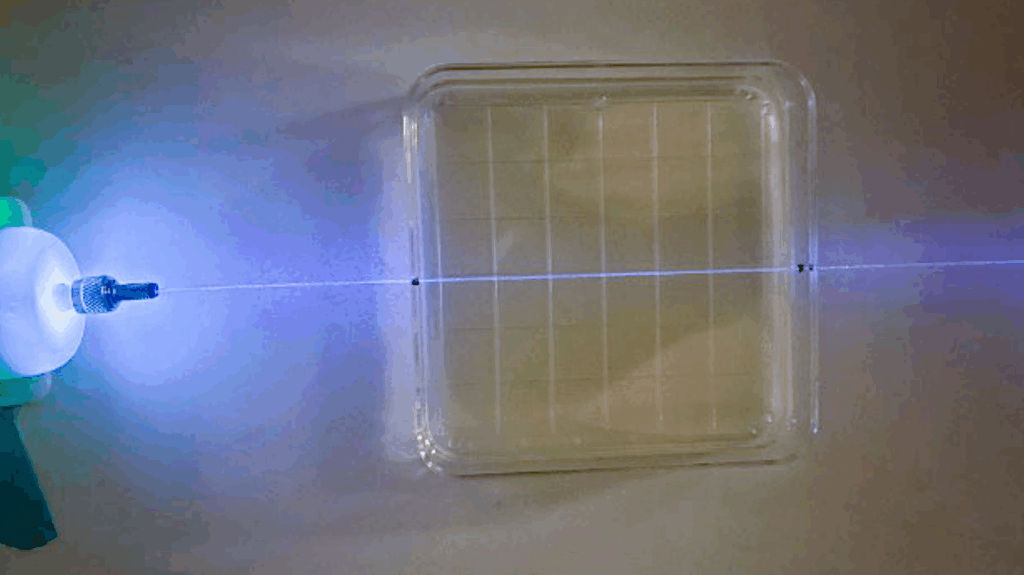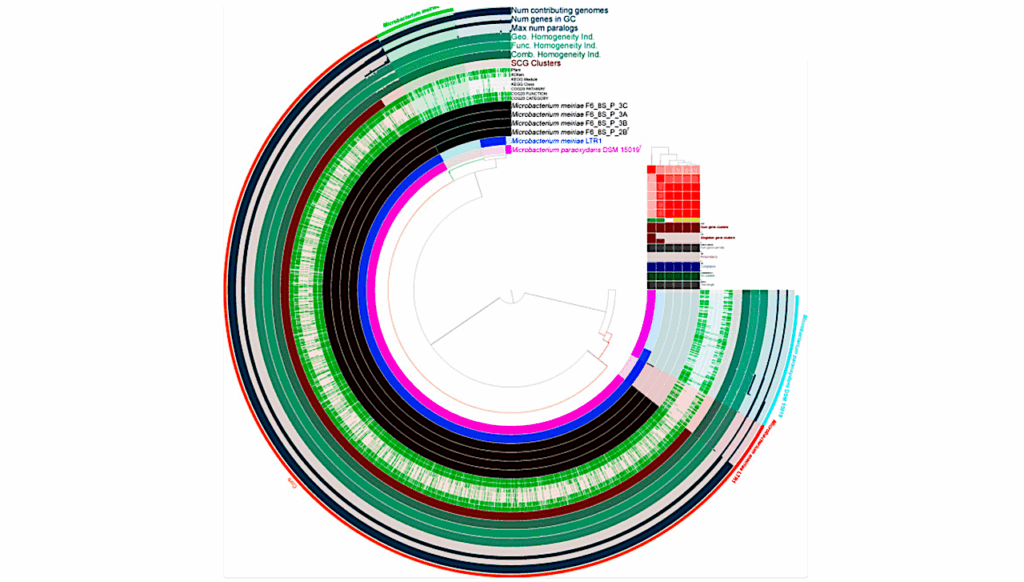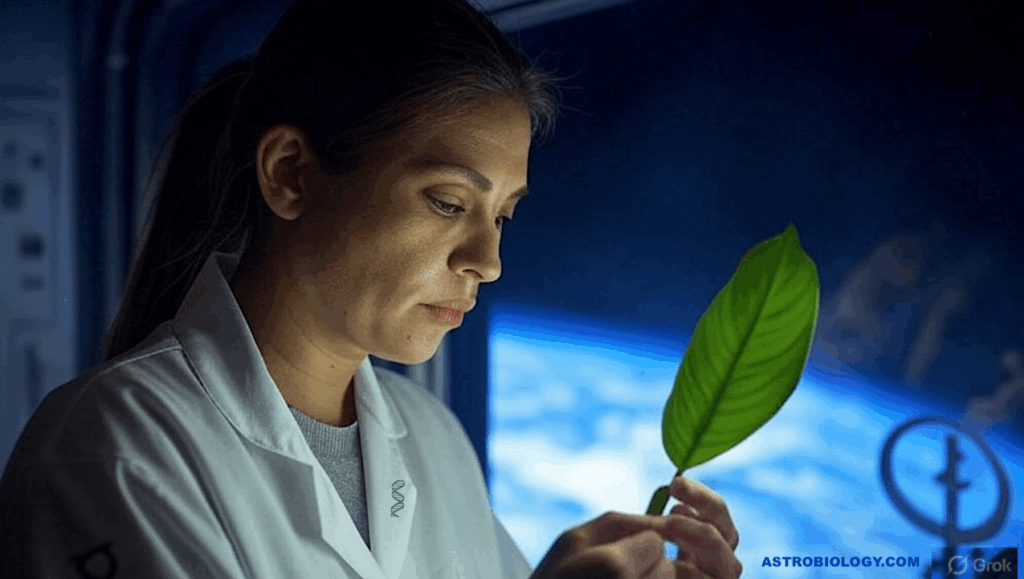NASA Spaceline Current Awareness List #1,062 18 August 2023 (Space Life Science Research Results)

The interior of the Biomass Production Chamber at Kennedy Space Center replicated the closed growing environment astronauts will use in space or on other planets to grow fresh crops. As the first controlled environment vertical farm in the United States, the chamber helped NASA provide critical data for the indoor farming industry. Credit: NASA
Papers deriving from NASA support:
- Flores P, McBride SA, Galazka JM, Varanasi KK, Zea L.Biofilm formation of Pseudomonas aeruginosa in spaceflight is minimized on lubricant impregnated surfaces.npj Microgravity. 2023 Aug 16;9(1):66.PI: L. ZeaNote: This article may be obtained online without charge.
Journal Impact Factor: 5.1
Funding: “This project was supported by the National Aeronautics and Space Administration under Grants No. 80NSSC17K0036 and 80NSSC21K1950.” - Pathare NN, Fayet-Moore F, Fogarty JA, Jacka FN, Strandwitz P, Strangman GE, Donoviel DB.Nourishing the brain on deep space missions: nutritional psychiatry in promoting resilience.Front Neural Circuits. 2023 Aug 17;17:1170395.PI: P. StrandwitzNote: This article is part of Research Topic “Brains in Space: Effects of Spaceflight on the Human Brain and Behavior-Volume II” (https://www.frontiersin.org/research-topics/47491/brains-in-space-effects-of-spaceflight-on-the-human-brain-and-behavior—volume-ii#overview). The Research Topic also includes articles from previous Current Awareness Lists #1,041 https://doi.org/10.3389/fphys.2023.1141078; #1,046 https://doi.org/10.3389/fncir.2023.1135434; #1,051 https://doi.org/10.3389/fphys.2023.1146096; # 1,053 https://doi.org/10.3389/fphys.2023.1141015; #1,056 https://doi.org/10.3389/fnins.2023.1180314; #1,059 https://doi.org/10.3389/fncir.2023.1190582 and https://doi.org/10.3389/fncir.2023.1197278; and #1,061 https://doi.org/10.3389/fphys.2023.1201253. This article may be obtained online without charge.
Journal Impact Factor: 3.5
Funding: “DD, JF, and GS are currently and PS was previously supported by the Translational Research Institute for Space Health (TRISH) through NASA NNX16AO69A.” - Tidwell JB, Taylor JA, Collins HR, Chamberlin JH, Barisano G, Sepehrband F, Turner MD, Gauthier G, Mulder ER, Gerlach DA, Roberts DR.Longitudinal changes in cerebral perfusion, perivascular space volume, and ventricular volume in a healthy cohort undergoing a spaceflight analog.AJNR Am J Neuroradiol. 2023 Aug 10. Online ahead of print.Note: Head-down tilt bedrest study.
Journal Impact Factor: 3.5
Funding: “Research reported in this study was facilitated by the Spaceflight Standard Measures Cross-Cutting Project of the Human Research Program of the National Aeronautics and Space Administration. We also thank the entire VaPER study staff.” - Britten RA, Fesshaye A, Tidmore A, Liu A, Blackwell AA.Loss of cognitive flexibility practice effects in female rats exposed to simulated space radiation.Radiat Res. 2023 Aug 1. Online ahead of print.PI: R.A. BrittenJournal Impact Factor: 3.4
Funding: “This work was funded by NASA grant support NNX14AE73G (RAB). The authors are indebted to Dr. Adam Rusek and his staff for their help with the irradiation of the rats at Brookhaven National Laboratories. This study would not have been possible without their help. Open Science: The individualized performance data will be available within NASA’s Open Science Data Repository and in Supplemental Data file.” - Chaklai A, Canaday P, O’Niel A, Cucinotta FA, Sloop A, Gladstone D, Pogue B, Zhang R, Sunnerberg J, Kheirollah A, Thomas CR, Jr., Hoopes PJ, Raber J.Effects of UHDR [ultra-high dose rate] and conventional irradiation on behavioral and cognitive performance and the percentage of Ly6G+ CD45+ cells in the hippocampus.Int J Mol Sci. 2023 Aug 6;24(15):12497.Note: This article is part of Special Issue “Radiation as a Double-Edged Sword: Cancer Therapy and Potential Harm” (https://www.mdpi.com/journal/ijms/special_issues/78179UR7O8). Additional articles will be forthcoming and may be found in the link to the Special Issue. This article may be obtained online without charge.
Journal Impact Factor: 5.6
Funding: “The irradiations were performed using the Dartmouth Cancer Center Irradiation and Imaging Shared Resource (5P30CA023108-40) as well as technology developed by the NIH NCI U01CA260446 grant. The mice were purchased, housed, irradiated, and shipped using the U01 funds. The OHSU Flow Cytometry Shared Resource is supported, in part, by the OHSU Knight Cancer Institute NCI Cancer Center Support Grant P30CA069533. This research was partially funded by NASA 80NSSC19K0498-P00001 and the development account of Dr. Raber.” - Faddegon BA, Blakely EA, Burigo LN, Censor Y, Dokic I, JN DK, Ortiz R, Ramos-Mendez J, Rucinski A, Schubert KE, Wahl N, Schulte RW.Ionization detail parameters and cluster dose: A mathematical model for selection of nanodosimetric quantities for use in treatment planning in charged particle radiotherapy.Phys Med Biol. 2023 Aug 14;68(17):175013.PI: E.A. BlakelyNote: This article was listed in the “Other articles of interest” section of Current Awareness list #1,061 and is being listed again in the NASA section along with the funding note.
Journal Impact Factor: 3.5
Funding: “EAB acknowledges support from NASA Grant #80JSC021T0017 (NNJ16HP22I) under contract #DE-AC02-05CH11231 with the U.S. Department of Energy, Office of Science.” - Leo P, de Melo Texeira M, Chander AM, Singh NK, Simpson AC, Yurkov A, Karouia F, Stajich JE, Mason CE, Venkateswaran K.Genomic characterization and radiation tolerance of Naganishia kalamii sp. nov. and Cystobasidium onofrii sp. nov. from Mars 2020 mission assembly facilities.IMA Fungus. 2023 Aug 11;14:15.PI: C.E. MasonNote: This article may be obtained online without charge.
Journal Impact Factor: 5.4
Funding: “The research described in this manuscript was funded by the NNH18ZDA001N-PPR award 18-PPR18-0011 to KV. …C.E.M. thanks the Scientifc Computing Unit (SCU) at WCM, the WorldQuant and GI Research Foundation, NASA (80NSSC22K0254, 80NSSC23K0832), the National Institutes of Health (R01MH117406), and the LLS (MCL7001-18, LLS 9238-16, 7029-23).” - Qiu Y, Wei GW.Artificial intelligence-aided protein engineering: From topological data analysis to deep protein language models.Brief Bioinform. 2023 Aug 14;bbad289. Online ahead of print.Note: From the abstract: “Protein engineering is an emerging field in biotechnology that has the potential to revolutionize various areas, such as antibody design, drug discovery, food security, ecology, and more. However, the mutational space involved is too vast to be handled through experimental means alone. Leveraging accumulative protein databases, machine learning (ML) models, particularly those based on natural language processing (NLP), have considerably expedited protein engineering. Moreover, advances in topological data analysis (TDA) and artificial intelligence-based protein structure prediction, such as AlphaFold2, have made more powerful structure-based ML-assisted protein engineering strategies possible. This review aims to offer a comprehensive, systematic, and indispensable set of methodological components, including TDA and NLP, for protein engineering and to facilitate their future development.” This article may be obtained online without charge.
Journal Impact Factor: 9.5
Funding: “This work was supported in part by NIH grants (R01GM126189, R35GM148196, and R01AI164266), NSF grants (DMS-2052983, DMS-1761320, and IIS-1900473), NASA grant (80NSSC21M0023), Michigan Economic Development Corporation, MSU Foundation, Bristol-Myers Squibb (65109), and Pfizer.” - Scarpa J, Parazynski S, Strangman G.Space exploration as a catalyst for medical innovations.Front Med (Lausanne). 2023 Jul 19;10:1226531.PI: G. StrangmanNote: This article may be obtained online without charge.
Journal Impact Factor: 3.9
Funding: PI reports partial support from TRISH Cooperative Agreement (NNX16O69A). - Waisberg E, Ong J, Masalkhi M, Zaman N, Sarker P, Lee AG, Tavakkoli A.The future of ophthalmology and vision science with the Apple Vision Pro.Eye (Lond). 2023 Aug 4.PI: A. TavakkoliNote: This article may be obtained online without charge.
Journal Impact Factor: 3.9
Funding: “NASA grant [80NSSC20K183]: a non-intrusive ocular monitoring framework to model ocular structure and functional changes due to long-term spaceflight. Open Access funding provided by the IReL Consortium.” - Guarnieri JW, Dybas JM, Fazelinia H, Kim MS, Frere J, Zhang Y, Soto Albrecht Y, Murdock DG, Angelin A, Singh LN, Weiss SL, Best SM, Lott MT, Zhang S, Cope H, Zaksas V, Saravia-Butler A, Meydan C, Foox J, Mozsary C, Bram Y, Kidane Y, Priebe W, Emmett MR, Meller R, Demharter S, Stentoft-Hansen V, Salvatore M, Galeano D, Enguita FJ, Grabham P, Trovao NS, Singh U, Haltom J, Heise MT, Moorman NJ, Baxter VK, Madden EA, Taft-Benz SA, Anderson EJ, Sanders WA, Dickmander RJ, Baylin SB, Wurtele ES, Moraes-Vieira PM, Taylor D, Mason CE, Schisler JC, Schwartz RE, Beheshti A, Wallace DC.Core mitochondrial genes are down-regulated during SARS-CoV-2 infection of rodent and human hosts.Sci Transl Med. 2023 Aug 9;15(708):eabq1533.PI: A. BeheshtiNote: This article may be obtained online without charge.
Journal Impact Factor: 17.1
Funding: “This work was supported by supplemental funds for COVID-19 research from Translational Research Institute of Space Health through NASA Cooperative Agreement NNX16AO69A (# T-0404 to A.B.)…”
Other papers of interest:
- Liu T, Melkus G, Ramsay T, Sheikh A, Laneuville O, Trudel G.Bone marrow adiposity modulation after long duration spaceflight in astronauts.Nat Commun. 2023 Aug 9;14(1):4799.Note: ISS results. This article may be obtained online without charge.
- Albornoz-Miranda M, Parrao D, Taverne M.Sleep disruption, use of sleep-promoting medication and circadian desynchronization in spaceflight crewmembers: Evidence in low-Earth orbit and concerns for future deep-space exploration missions.Sleep Med X. 2023 Dec 15;6:100080. Review.
- Krittanawong C, Isath A, Kaplin S, Virk HUH, Fogg S, Wang Z, Shepanek M, Scheuring RA, Lavie CJ.Cardiovascular disease in space: A systematic review.Prog Cardiovasc Dis. 2023 Jul 31;S0033-0620(23)00075-0. Review. Online ahead of print.
- Ravizza M, Giani L, Sheiban FJ, Pedrocchi A, DeWitt J, Ferrigno G.IMU-based classification of resistive exercises for real-time training monitoring on board the International Space Station with potential telemedicine spin-off.PLoS One. 2023 Aug 10;18(8):e0289777.Note: From the abstract: “The microgravity exposure that astronauts undergo during space missions lasting up to 6 months induces biochemical and physiological changes potentially impacting on their health. As a countermeasure, astronauts perform an in-flight training program consisting in different resistive exercises. To train optimally and safely, astronauts need guidance by on-ground specialists via a real-time audio/video system that, however, is subject to a communication delay that increases in proportion to the distance between sender and receiver. The aim of this work was to develop and validate a wearable IMU-based biofeedback system to monitor astronauts in-flight training displaying real-time feedback on exercises execution.” This article may be obtained online without charge.
- Hatsuda M, Kawasaki H, Shigenaga A, Taketani A, Takanashi T, Wakabayashi Y, Otake Y, Kamata Y, Ichinose A, Nishioka H, Kimura H, Koganei Y, Komoriya S, Sakai M, Hamano Y, Yoshida M, Yamakura F.Effects of neutron radiation generated in deep space-like environments on food resources.Sci Rep. 2023 Aug 1;13:12479.Note: This article may be obtained online without charge.
- Lanéelle D, Ogoh S, Trihan JE, Bailey DM, Normand H.Selective elevation in external carotid artery flow during acute gravitational transition to microgravity during parabolic flight.Am J Physiol Heart Circ Physiol. 2023 Aug 11. Online ahead of print.Note: From the abstract: “This study sought to determine to what extent acute exposure to microgravity (0G) and related increases in central blood volume (CBV) during parabolic flight influence the regional redistribution of intra and extra cranial cerebral blood flow (CBF).”
- Proske U, Weber BM.Proprioceptive disturbances in weightlessness revisited.npj Microgravity. 2023 Aug 11;9(1):64. Review.Note: This article may be obtained online without charge.
- Ratushnyy AY, Tyrina EA, Buravkova LB.Simulation of microgravity and coculturing with hematopoietic cells oppositely modulate Wnt signaling in mesenchymal stromal cells.Dokl Biochem Biophys. 2023 Aug 15;510:95-8.Note: The method of simulated microgravity is not evident in the available abstract.
- Xiong Y, Ma C, Li Q, Zhang W, Zhao H, Ren P, Zhang K, Lei X.Melatonin ameliorates simulated-microgravity-induced mitochondrial dysfunction and lipid metabolism dysregulation in hepatocytes.Faseb j. 2023 Sep;37(9):e23132.Note: A random positioning machine was used in this study.
- Badalì C, Wollseiffen P, Schneider S.Under pressure-The influence of hypergravity on electrocortical activity and neurocognitive performance.Exp Brain Res. 2023 Aug 4.Note: From the abstract: “The effects of hypergravity and the associated increased pressure on the human body have not yet been studied in detail, but are of great importance for the safety of astronauts on space missions and could have a long-term impact on rehabilitation strategies for neurological patients. Considering the plans of international space agencies with the exploration of Mars and Moon, it is important to explore the effects of both extremes, weightlessness and hypergravity.”
- Wang Z, Wang XC, Chen YF, Wang CL, Chen L, Jiang MY, Liu XW, Zhang XX, Feng YZ, Xu JH.Loss and recovery of myocardial mitochondria in mice under different tail suspension time: Apoptosis and mitochondrial fission, fusion, and autophagy.Exp Physiol. 2023 Aug 11. Online ahead of print.Note: Hindlimb unloading study.
- Zhang M, Yang X, Wu X, Liu L, Wang S, Sun L, Fan Y.Effect of collagen fiber orientation on mechanical properties of bone and myofascia in hindlimb unloading rats.Acta Astronaut. 2023 Nov;261-69.Note: Hindlimb unloading study.
- Bosio VE, Rybner C, Kaplan DL.Concentric-mineralized hybrid silk-based scaffolds for bone tissue engineering in vitro models.J Mater Chem B. 2023 Aug 1. Online ahead of print.
- Wong KC, Sun EY, Wong IOL, Kumta SM.Mixed reality improves 3D visualization and spatial awareness of bone tumors for surgical planning in orthopaedic oncology: A proof of concept study.Orthop Res Rev. 2023 Jul 31;15:139-49.Note: From the abstract: “In orthopedic oncology, computer navigation and 3D-printed guides facilitate precise osteotomies only after surgical exposure. Before surgeries start, it is challenging to mentally process and superimpose the virtual medical images onto patients’ anatomy for preoperative surgical planning. Mixed Reality (MR) is an immersive technology merging real and virtual worlds, and users can interact with digital objects in real time. Through Head-Mounted Displays, surgeons directly visualize holographic models that overlaid on tumor patients. The technology may facilitate surgical planning before skin incisions.” This article may be obtained online without charge.
- Lyons LJ, Kazemi A, Bakri SJ, Barkmeier AJ, Iezzi R, Olsen TW, Hodge DO, Sit AJ.The effect of scleral buckle surgery on tonographic outflow facility, positional intraocular pressure and ocular biomechanics.Ophthalmol Glaucoma. 2023 Jul 22. Online ahead of print.
- Kim HJ, Lee CM, Rundfeldt HC, Lee S, Lee I, Jansen K.Convergence of phase-averaged, transitional flow in an abdominal aortic aneurysmal model.J Biomech Eng. 2023 Nov 1;145(11):111007.
- Palma J, Kim J, Hoffman JW, Ellis SJ, Demetracopoulos CA, Steineman BD.Hindfoot arthrodeses and the order of joint fixation influence tibiotalar kinematics during simulated stance.Foot Ankle Int. 2023 Aug 5:10711007231184224. Online ahead of print.Note: From the abstract: “Although hindfoot arthrodeses relieve pain and correct deformity, they have been associated with progressive tibiotalar degeneration. The objective was to quantify changes in tibiotalar kinematics after hindfoot arthrodeses, both isolated subtalar and talonavicular, as well as double arthrodesis, and to determine if the order of joint fixation affects tibiotalar kinematics.”
- Valentina N, Monfort SM, Claudio D.Exploring the influence of individual factors on the perception of mental workload and body postures.Ergonomics. 2023 Aug 7:1-19. Online ahead of print.
Astrobiology, Space Biology,








